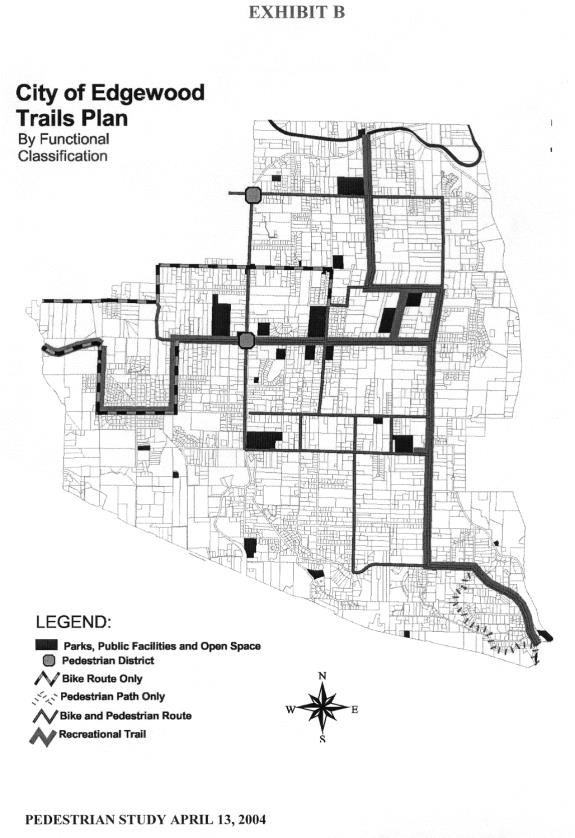Chapter 12.12
NONMOTORIZED TRANSPORTATION SYSTEMS
Sections:
12.12.030 General development standards.
12.12.040 Specific development standards.
12.12.010 Purpose.
The city requires motorized and nonmotorized transportation systems to move goods and people. Motorized transportation systems are those streets and roads that carry motorized vehicles. Nonmotorized systems are those involving trails, sidewalks, pathways and linear parks that handle pedestrians, bicycles and other nonmotorized modes of transportation. Within the city of Edgewood, proper pedestrian facilities are a community goal. (Ord. 06-269 § 3).
12.12.020 Scope.
The nonmotorized transportation system encompasses the entire community. These include adequate facilities for trails, pathways, sidewalks and linear parks that connect to all community, educational, recreational and commercial facilities. (Ord. 06-269 § 3).
12.12.030 General development standards.
New development shall provide adequate nonmotorized transportation systems in accordance with the following city standards:
A. Provide internal pedestrian circulation by means of sidewalks and trails.
B. Connect internal trails and sidewalks to other residential, community, recreational, educational or commercial areas via area trails.
C. City standards for the pedestrian circulation are:
1. Major citywide recreational trails to community facilities are to be no more than one-half mile apart.
2. Provide trails and/or sidewalks that shall connect all residential areas to schools, parks and major commercial areas.
3. The city of Edgewood pedestrian safety study alternative strategies trail map, and other studies approved by the city council, shall be used as a guide.
4. The pedestrian safety study alternative strategies trail plan map and the interurban trail shall serve as the basis for developing and connecting the city’s public trail system. (Ord. 06-269 § 3).
12.12.040 Specific development standards.
The development of pathways and trails shall be designed to meet the following criteria. These standards may be modified when, in the opinion of the city engineer, it would allow for better nonmotorized movement due to environmental constraints:
|
Type of Nonmotorized Improvement |
Typical Width* |
Required Surface |
Development Criteria |
|---|---|---|---|
|
On-street bicycle pathway |
5 feet |
Concrete, asphalt, or other all-weather surface materials |
Striped lane within the street right-of-way |
|
Off-street paved bicycle/pedestrian pathway |
6 – 12 feet |
Concrete, asphalt, or other all-weather surface materials |
Reflect local site conditions |
|
Off-street unpaved bicycle/pedestrian pathway |
6 – 12 feet |
Gravel, wood chip, natural earth or similar materials |
Reflect local site conditions |
|
On-street separated bicycle/pedestrian pathway |
5 – 8 feet |
Asphalt or other all-weather surface materials |
Separated from the roadway by a 4-foot-wide buffer |
|
Sidewalks |
5 feet |
According to street design standards set forth in Chapter 12.05 EMC |
|
*Lower number of the range is the minimum width unless modified by the city engineer.
(Ord. 06-269 § 3).



